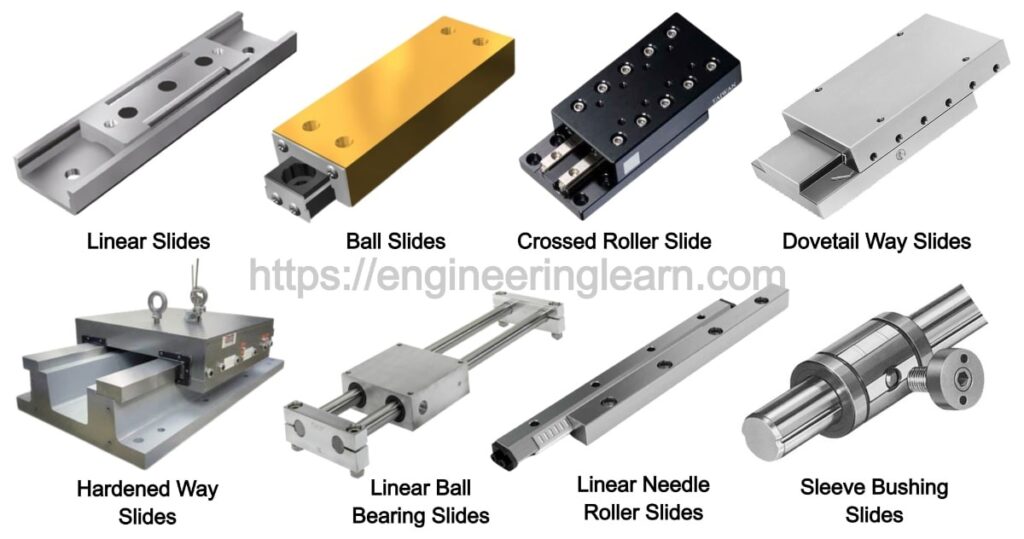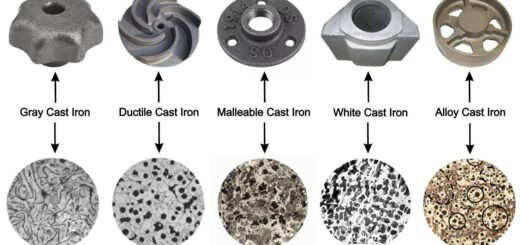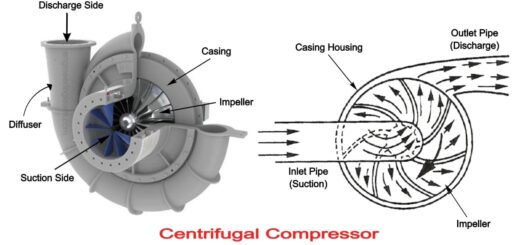Linear Slides (Linear Guide): Types, Components, Specifications, Features & Applications

What is Linear Slides?
Linear Slides (Linear Guide): Types, Components, Specifications, Features & Applications :- Linear slides are referred to as those slides and stages which are responsible for providing smooth, accurate linear motion and positioning for various types of automated machineries. These are the slides which uses one amongst several linear bearing methods in order to reduce the effect of friction, stick-slip and extra energy expenditure. Linear slides can also be defined as the ones which are similar to a simple linear motion devices and is found having a composition of a stationary base and a moving carriage.
Linear stages are those slides which is accompanied with a drive mechanism which provides controlled and precise position along with the linear axis. Linear slides and the linear stages are responsible for using a linear bearing in order to reduce the friction and to guide the slide. So, Here is a handy guide which help you in learning a lot about types of slides and all its details.
Types of Linear Bearing
Common linear bearing types which are used in linear slides are as follows:
- Air bearings
- Ball slides
- Crossed rollers bearings
- Dovetail ways
- Hardened ways/ box ways
- Linear ball bushings
- Linear motion guides
- Linear needle roller bearings/ M/V ways
- Sleeve bearings
Considering the rail or any stationary members of the linear bearings, these are the ones which are found to be assembled along with a base and a carriage which is then assembled to the moving member of the bearing. The linear bearing is responsible for providing a low-friction, smooth and accurate linear motion for the easy and hassle free carriage.
Linear slides are referred to as those slides which are typically used as a ball screw or lead screw and is supported by the rotary bearings as a drive mechanism in order to move the carriage. The screw is found to be fixed to the base, and the nut assembly is attached to the moving carriage. As soon as the screw starts the rotation, the nut along with the carriage moves linearly along the screw. The screw is then turned using a hand wheel or an electric motor which may or may not be included in the slide.
Other than this the alternative drive mechanism can also be used which do not require a ball screw or lead screw, like the linear motors, pneumatic cylinders and hydraulic cylinders. For instance, in a linear motor driven slide, the linear motor is found to directly approach the carriage along the slide. Pneumatic cylinders as well as thee hydraulic cylinders can be used. The cylinder body is found to be fixed to the slide base and the cylinder rod is found to be attached to the carriage.
Components of Slides
Here are some of the components of slides about which one must know so that working at sites becomes easier.
1. Base
The Base is most commonly found to be stationary which can also be mounted to a machine or any other surface. The base is usually found to be supported at the slide linear bearing, motor and screw components, if it is found to be present. The base of the slides is found to be made of materials like cast iron, steel or aluminum.
2. Carriage
The carriage is the component which is commonly found to be the moving component of the slide and is also known to be mounted to the moving member of any linear bearing or the driver. The carriage is equally responsible for supporting a spindle, machine subassembly or other components that purposely requires a linear movement. The carriage is mostly found to be of materials like cast iron, steel or aluminum.
3. Linear Bearing
The linear bearing can be incorporated into the base of the dovetail slide or the box way slide or can also any purchased bearing can be used in the sliding assembly.
4. Ball Screws and Lead Screws
Ball screws and lead screws are the components which are usually used in order to provide the precise and repeatable motion to any linear slide. The screw is most commonly mounted to the base, supported by a rotary bearing assembly and then the screw nuts are mounted to the carriage. Once the screw is rotated manually or through motor, the nut and the carriage moves along the screw.
5. Linear Motors
Linear motors are referred to as those which are used to provide accurate positioning of the carriage. Linear motors are found generating high forces along with the higher acceleration rates and speeds.
6. Pneumatic or Hydraulic Cylinders
Pneumatic or hydraulic cylinders are referred to as those which use a gas or liquid pressurized piston in order to determine the linear placement of the carriage.
Types of Slides / Types of Linear Slides
1. Linear Slides
Linear slide is referred to as that slide which is found along with the air bearings which rides on a thin cushion of air, in order to provide support in only one direction. Air bearing slides are referred to as those which are practically found to be frictionless and also provide no stick slip. Some of the applications of air bearing slides are found including inspection systems, machine tools, pick and place devices etc.
2. Ball Slides
Ball slide is referred to as that slide which uses a bearing system that is composed of two rows of balls on both the sides of the base. Ball slides are found having applications that have minimal shock accompanied with the impact loads.
3. Crossed Roller Slide
These are named in such a way as they are found having slides with crossed roller bearings and also contain a series of rollers which are enclosed in rails with the help of machine, V-shaped grooves are found to be grounded at an angle of 90° whereas the crossed roller bearings are the ones which can carry heavy loads and can take up to little space in the slide assembly in order to provide accurate positioning.
4. Dovetail Way Slides
Dovetail way slides are referred to as those slides which are found providing a lower profile, higher stiffness and load capacities specifically for the linear positioning of the tools of the machine, instrumentation and automation equipment. Dovetail slides are the ones which can withstand vibrations and shock better as compared to the linear bearing slides.
5. Hardened Way Slides
Hardened way slides are the ones which are also referred to as box way slides and are found to be quite similar to the dovetail slides but use the direct contact of the base and saddle.
6. Linear Motion Guide Slides
Linear motion guide slides are the ones which are also termed as square rail linear bearings and is found including a guide rail along with the carriage unit. The linear motion guide bearings are sometimes referred to the acronym of linear motion guide bearings as they can provide great accuracies, stiffness and the load carrying capacity is found to be appreciable.
7. Linear Ball Bearing Slides
Linear ball bearing slides are referred to as those which are found containing recirculating linear balls, which rides on hardened, ground linear shafts. The linear ball bearing is also referred to as a linear bushing which is typically mounted on the carriage or round flanged housing. Linear ball bearings are the ones which have the potential to accommodate torsional misalignment better as compared to the other linear bearing designs.
8. Linear Needle Roller Slides
Linear needle roller slides are also known as M/V ways which is found containing a V-shaped bearing retainer and is responsible for containing the rows of a needle roller. The cage of a needle roller is found to be mounted within the two machine rails, one machined along with the concave V shape or the M rail whereas the other one mounted with a convex V shape or the V rail. The linear needle roller bearing slides can have very high load-carrying capacity along with the higher stiffness and can also offer accurate movements. The linear needle roller bearings are also known to be as precise rail guides.
9. Sleeve Bushing Slides
Sleeve bushing slides are referred to as those slides which are found using a sleeve bearing design. The sleeve bearings are also referred to as bushings which are round plain bearings. The sleeve bearings are the ones which is similar to linear ball bushings, but on the same time does not contain any rolling element. These slides can be usually operated on nearly no lubrication or maintenance. This is the reason which makes them suitable for a wider range of applications like packaging machinery, food processing equipment and various others.
Specifications of Slides
1. Number of Axes
A single-axis system is found having only one carriage or saddle which is found moving along the X-axis. The vertical lift devices are used to move along the Z-axis.. Others are found to include one carriage which moves along the X-axis and another carriage that moves along the Z-axis. There are three-axis system which provides motion in three orthogonal axes. Some of the most important travel specifications which are required for the linear slides as well as the linear stages are found including the X-axis linear travel, Y-axis linear travel and Z-axis linear travel.
2. Slide Accuracy
Slide accuracy is one of the most important specification which is done to mainly determine the usage of bearing or way system. The linear bearings are found to provide extreme accuracy along with the repeatable motion.
3. Linear Travel
Linear travel is referred to as the total stroke of the slide which is considered from one end to the other
4. Load Capacity
The load capacity is another important specification which is responsible for telling you the total load which can be carried by the slide without suffering any permanent damage or failure.
5. Linear Speed
The linear speed is referred to as the maximum velocity of the carriage which can move along the positioning axis.
6. Load, Moment and Stiffness Ratings
Load, moment and stiffness ratings is referred to as the construction of the slide along with the bearing or in the way the system is found to determine the load capacity, moment rating and stiffness of the slide.
7. Drive Mechanism Type
Drive mechanism type is found to be very stiff, repeatable slides can require a ball screw drive accompanied with a motor. The manual positioning applications are known to be well suited along with a ball or a lead screw and a hand wheel. The pneumatic and hydraulic drives are the ones which are mostly found to be highly used for the quick actuation which is not found requiring any accuracy or precision and the repeatability of a motor driven slide.
Features of Slides
- A linear slide or stage may include one or more of the following features:
- A brake/lock assembly for slowing or stopping the linear motion, or a lock for maintaining the carriage position.
- A clutch assembly for connection or disconnection of the drive mechanism.
- A combination brake/clutch assembly for slowing or stopping the linear motion (brake) and connection or disconnection of the drive mechanism (clutch).
- The double carriage slide or stage is equipped with two sliding carriages.
- A rotary axis where the last axis (Y or Z) is capable of rotary motion.
- A stackable slide or stage that can be stacked (one on top of another) to provide linear motion in more than one axis.
- A side motor or side motor mount is offered to fit in smaller spaces.
- Way covers, which are sometimes referred to simply as bellows, cover the rails/guides for protection from dust and dirt.
- The unit is equipped with wipers or scrapers for cleaning the surface of the rails/guides.
Applications of Linear Slides
- Linear slides are used in many applications requiring a linear motion. Some examples include machine tools, packaging equipment, metrology equipment, processing equipment, pick and place and other material equipment, and many others.
- Some linear slides are found to be quite suitable for the unique work.
- Cleanroom Rated – The unit is certified for use in cleanroom environments. Cleanroom requirements are found to be typically specific in terms of the magnitude like 1, 10, 100, 1000, 10,000, which relates the particles per million and defines the actual particle size.












